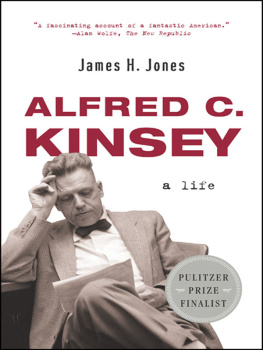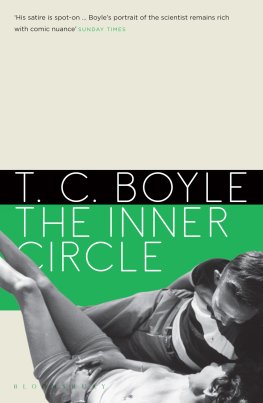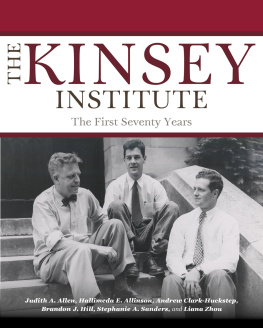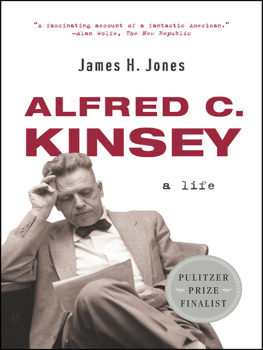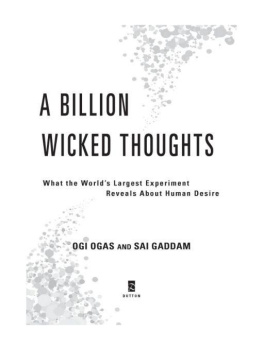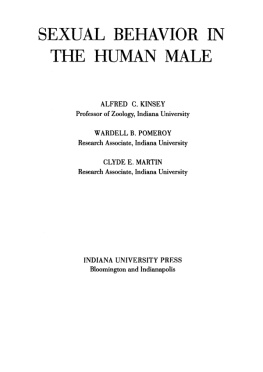A fascinating account of a fantastic American.
Alan Wolfe, The New Republic
James H. Jones
ALFRED C. KINSEY
a Life

C ONTENTS

I n August 1956, Alfred Charles Kinsey, the worlds most famous sex researcher, lay dying. Pneumonia had put him in the hospital, but heart disease had been grinding him down for decades. The last few years had been particularly nasty, as he waged his losing battle against chest pains, shortness of breath, and fluid buildup in his lungs, the classic symptoms of congestive heart failure. This is not a gentle death, and Kinsey was suffering greatly.
Yet far greater than his physical pain was the torment that had gripped his soul. Things had not gone well for Kinsey since 1953 when his portrait had appeared on the cover of Time magazine. Sales of Sexual Behavior in the Human Female (1953), his long-awaited sequel to Sexual Behavior in the Human Male (1948), had been disappointing; a congressional committee had investigated his research and all but accused him of being a Communist; the Rockefeller Foundation, his financial patron, had withdrawn its support; and financial problems were threatening to close his beloved Institute for Sex Research.
The prospect of seeing his lifework destroyed was more than Kinsey could bear. For nearly two decades, he had devoted himself to sex research, working at a feverish pace and with a single-mindedness that left everyone who knew him in awe. Together, he and his coworkers had interviewed over 18,000 people, compiling more data on human sexual behavior than any scientists before them. This was the public part of his research, the work known to the world.
Privately, Kinsey had always been more than a fact-finder. He was a social reformer, a man who waged with fanatical consistency his own private war against sexual repression and hypocrisy. Always he had been sustained by the belief that he would win. Once people learned the facts about human sexual behavior, he reasoned, they would jettison guilt and embrace their sexuality with abandonment and joy. By 1956, however, Kinsey was a broken man. He had come to despair of victory, believing he had failed to produce significant changes in the sexual attitudes, mores, and laws of the United States.
Why had Kinsey cared so passionately and worked so hard all those years? The answer lies in his private life, in the fearful things he had kept hidden from the world. Kinsey was a man with secrets, a man whose stupendous guilt had combined with his puritan work ethic to produce his spring-coil vitality.1 Beginning with childhood, Kinsey had lived with secrets about his own sexuality, and he had spent his life deeply conflicted. Yet Kinsey understood firsthand how difficult it was to change his sexual needs, and he knew better than to expect sympathy or understanding from society. In order to help himself, he would have to help others. Thus, his messianic crusade to reform the world that oppressed him.
Kinseys guilt about his sexuality was hardly unique. It mirrored, albeit in exaggerated form, the sexual tensions and anxieties of his generation. Many late-nineteenth and early-twentieth-century Protestants, middleclass, and small-town Americans felt anxious and guilty about sex. They simply could not reconcile their cultures demands for moral rectitude with their own sexual needs and desires. To understand how Kinseys complex character was formed, our search should begin with his childhood, for it was then that he developed his love for science and first took up the heavy burden of self-criticism.
* * *
Flowers. As objects of beauty, they are supposed to make people happy, but they made Alfred Charles Kinsey sad. Not all flowers, to be sure. Only those that had grown in his familys tiny yard in Hoboken, New Jersey, where he spent the first ten years of his life. He disliked Hoboken and everything connected with it, Clara Kinsey, his wife, later told an interviewer, even the flowers that grew in the garden they had in their small backyard.2 As an adult, Kinsey became an ardent gardener, but he would not permit marigolds, zinnias, or wisteria in his yardthe flowers his parents had grown in Hoboken. While his reaction was truly visceral, it was not the flowers he loathed but the childhood memories they triggered.3 Not that he dwelled on these years, for Kinsey believed that bad memories should be suppressed. As an adult, he advised young people to learn the art of weighing down unprofitable things in our thoughts. Referring specifically to unwanted memories, Kinsey added, We may not be responsible for the birds (memories) that fly over our heads but we can keep them from roosting in our hair.4
After he gained world fame as a sex researcher, Kinsey received numerous inquiries about his past. People wanted to know his birthday, where he had been born, the names of his ancestors, whether he was married and had children, and even intimate details about his sex history. For a man who had become a celebrity by invading other peoples privacy, he guarded his own with cool determination.5
Many of the inquiries came from people who wondered if they might be related. In response, Kinsey revealed only the barest details about his family. Mostly, he talked about genealogy, telling one would-be relative that Kinsey was the English version of the Scottish name MacKinsey and that his forebears had crossed the ocean with the Quaker William Penn, who founded Philadelphia.6 Indeed, he maintained that all present-day Kinseys living in the United States could trace their ancestry back to the three brothers who accompanied Penn.7 Nor was Kinsey above claiming distinguished personages for his family tree. He boasted that one of the original three brothers became a famous jurist in New Jersey,8 while other Kinseys rose to the office of state treasurer in both New Jersey and Pennsylvania during colonial times.9
Here he must have been repeating family lore, for he offered no genealogical evidence to prove his ancestry. According to Kinsey, descendants of the three brothers who helped found Pennsylvania eventually moved out of Philadelphia into other parts of the country. One group moved to New Jersey and New York, another to Indiana and Ohio, and still a third to San Francisco.10
Both truth and error attended Kinseys version of history. Men who bore his family name had indeed been important leaders in colonial days. John Kinsey (16931750), a brilliant Quaker lawyer, politician, and jurist, was elected the speaker of the New Jersey assembly before moving to Philadelphia, where he enjoyed even greater success, serving at different times as speaker of the Pennsylvania assembly, attorney general of the province, and chief justice of the supreme court of Pennsylvania. His son, James Kinsey (17311803), also compiled a distinguished record of public service, following his father into the law, winning election to the Continental Congress, and serving as chief justice of New Jerseys supreme court.11
By the end of the American Revolution, scores of Kinseys lived in what became the northeastern United States, but Alfred Charles Kinseys belief that all modern-day Kinseys derived from three Pennsylvania brothers was mistaken. Numerous Kinseys immigrated from the British Isles directly to the United States in the seventeenth and eighteenth centuries, and many more followed in the nineteenth. Nevertheless, two (not three) Kinsey brothers did accompany William Penn on his journey to Pennsylvania in 1682, and it is possible (although by no means certain) that Alfred Charles Kinsey descended from one of them.12
Because he seldom spoke of his childhood, Kinseys silence allowed others to speculate about his background. Before he became world famous, many of his graduate students at Indiana University had the distinct impression that Kinsey came from a well-to-do family. Perhaps it was his eastern accent, his educational pedigree (Bowdoin College undergraduate, Harvard University graduate school), and his intimidating knowledge of classical music, or maybe it was the stiff, formal bearing he often displayed. Whatever the explanation, many people found Kinsey cool and aloof, every inch a portrait of old money, with more than a sliver of ice in his heart. One of his former graduate students complained of Kinseys upper-class arrogance.13
Next page
